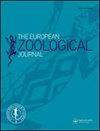Olsztyn(波兰东北部)城市地区小型水体中两栖动物群落多样性的长期变化
IF 1.4
4区 生物学
Q2 ZOOLOGY
引用次数: 0
摘要
摘要长期研究在预测生态变化方面变得越来越重要,尽管只有少数研究报道了城市地区两栖动物群落在长时间尺度上的变化。该研究的主要目的是确定1997年至2015年间,两个Olsztyn(波兰东北部)定居点小水体中两栖动物群落的数量和物种组成的变化。所调查的定居点的特点是小水体高度集中,城市化程度不同。1997年至2015年间,两个定居点的繁殖两栖动物群落的多样性指数都有所下降。在18年的时间里,一种物种——北冠蝾螈——从两个定居点消失了,另一种——火腹蟾蜍——从其中一个定居点消失。我们证明了火腹蟾蜍、普通蛙、食用蛙和池蛙占用水库的概率与这些水库的隔离程度之间的显著关系。此外,还观察到单个水体中物种的平均数量和多样性的平均值有所下降。水库中两栖动物群落的多样性主要取决于与最近的水库的距离、最近的建筑物和水库中的植被面积。现有数据表明,新建的水库在保护城市空间中的两栖动物方面发挥了积极作用,但当地两栖动物群落的恢复与城市化程度有关,大多适用于多面手物种。本文章由计算机程序翻译,如有差异,请以英文原文为准。
Long-term changes in the diversity of amphibian communities inhabiting small water bodies in the urban area of Olsztyn (NE Poland)
Abstract Long-term research has become increasingly important in predicting ecological changes, although only a few studies have reported changes in amphibian communities over long time scales in urban areas. The main aim of the research was to determine the changes in the number and species composition of amphibian communities in small water bodies of two Olsztyn (NE Poland) settlements in the period between 1997 and 2015. The examined settlements are characterized by a high concentration of small water bodies and different degrees of urbanization. A decrease in the diversity index of reproducing amphibian communities was found between the years 1997 and 2015 at both settlements. Over the period of 18 years, one species – the northern crested newt – disappeared from both settlements, and another – the fire-bellied toad – disappeared from one of the two settlements. We demonstrate a significant relationship between the probability of occupancy of a water reservoir by fire-bellied toad, common frog, edible frog, and pool frog and the degree of isolation of these water reservoirs. Moreover, a decrease in the average number of species in a single water body and in the average values of diversity was also observed. The diversity of amphibian communities in water reservoirs depended mainly on the distance to the nearest water reservoir, the nearest building and the area of vegetation in the water reservoir. Available data suggests that the newly created water reservoirs play a positive role in the protection of amphibians in urban spaces, but the restoration of local amphibian communities is related to the degree of urbanization, and mostly applies to generalist species.
求助全文
通过发布文献求助,成功后即可免费获取论文全文。
去求助
来源期刊

European Zoological Journal
Agricultural and Biological Sciences-Animal Science and Zoology
CiteScore
3.10
自引率
5.60%
发文量
80
审稿时长
30 weeks
期刊介绍:
The European Zoological Journal (previously Italian Journal of Zoology) is an open access journal devoted to the study of all aspects of basic, comparative and applied protozoan and animal biology at molecular, cellular, tissue, organ, organismal, population, and community-ecosystem level. Papers covering multiple levels of organization and integrative approaches to study animal form, function, development, ecology, evolution and systematics are welcome. First established in 1930 under the name of Il Bollettino di Zoologia, the journal now has an international focus, reflected through its global editorial board, and wide author and readership.
 求助内容:
求助内容: 应助结果提醒方式:
应助结果提醒方式:


